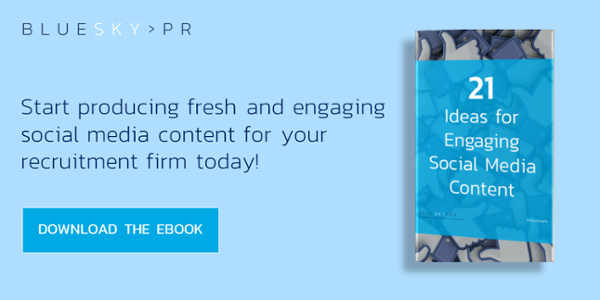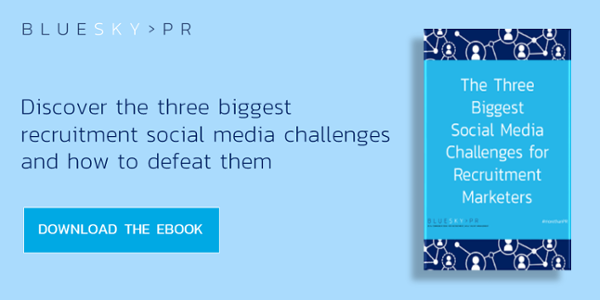Social Media for Recruitment

Contents
- Why are recruitment agencies using social media?
- What social media platforms should my recruitment firm be using?
- How to secure social media buy-in at your recruitment business
- Why your CEO should be using social media
- What is a social media strategy? And does my recruitment firm need one?
- How to create a social media strategy
- The benefits of using paid social for recruitment firms
- Should recruitment firms outsource social media?
Why are recruitment agencies using social media?
With over 45 million users in the UK alone, social media has become a vital component of a recruitment agencies’ marketing strategy, providing a multitude of ways for recruiters to source and engage with new talent and develop a strong brand presence in their respective markets. Yet there are still many firms out there failing to recognise how social media can help them achieve their top-level business objectives.
Here are just some of the ways that social media can benefit recruitment agencies:
- Employer brand – With 59% of potential employees using social media to learn more about prospective employers, the need to promote a positive brand experience across your channels has fast become an essential part of the candidate attraction process.
This has become increasingly important in recent years as research shows that 88% of millennials, a group that is set to make up 75% of the global workforce by 2025, want to work for a company with values that reflect their own. Therefore, recruitment firms that highlight their cultures and values on social media are much more likely to attract high-calibre talent. - Recruiting – Over the last decade or so, social media has provided recruiters with the opportunity to create a strong digital presence where they can reach, engage with and source both passive and active candidates. And, of course, while LinkedIn immediately springs to mind, many recruiters are also having success on Twitter and Facebook, as well as niche sector-specific platforms such as Procurious.
- Candidate screening – With many candidates including social media links on their CVs to help showcase their passion and knowledge of a particular industry, this means that recruiters can learn a lot more about individuals’ personal and professional qualities to see if they are the right match for the roles that they are hiring for.
- Reaching new and existing audiences – From using organic posts to keep your followers updated on the latest roles, blogs and industry news, to creating paid campaigns that target individuals that align with your personas, social media has a number of options that can enable your firm to get its content in front of the right audience at the right time.
- Maximising marketing and PR activities – Social media provides recruitment firms with another channel to amplify their ongoing marketing and PR efforts and generate a higher ROI. From running a multi-channel brand campaign to showcasing top tier PR coverage, social media provides a number of ways in which companies can leverage their content to increase brand awareness.
What social media platforms should my recruitment firm be using?
With over 45 million social media users in the UK, deciding which social media platforms your recruitment business should have a presence on can be extremely confusing. However, it is key that you avoid adopting a ‘spray and pray’ approach whereby you establish a presence on every single platform. While this may initially seem like a good idea to reach as much of your audience as possible this is in fact counterproductive as you will be stretching your time and resources on platforms where your audiences may be spending little, if any time. This is why creating candidate and client personas are so important in gaining a thorough understanding of your audiences and how they behave. For example, if you are placing higher-level management applicants it is likely that your core audience will be active on LinkedIn and Twitter rather than Facebook and Instagram – therefore you should use your time wisely and invest resources in developing content for these platforms.
How recruitment firms can use Twitter effectively
With over 16.7 million users in the UK, Twitter is an incredibly popular platform. Its focus on providing real-time updates has made it the go-to platform to find out the latest breaking news across a number of different industries and sectors.

The Twitter algorithm
Twitter’s algorithm uses a ranking system to determine which tweets from accounts that its users follow are going to be the most relevant or interesting to them.
Here are five key algorithm factors that recruitment marketers need to be aware of.
Recency - With breaking news stories and trending topics a core focus of the platform, timely posts are weighted heavily in Twitter’s algorithm and will more often than not appear towards the top of a user’s timeline fed.
User interests - The algorithm uses platform data to show users more of the content they have an interest in. For example, if one of your followers is currently looking for a new job and engages with tweets sharing CV and interview tips, then this type of content will feature more prevalently in their timeline.
Credibility - With Twitter still feeling the effects of ongoing allegations concerning Russian bots using the platform to interfere with political events, it is clamping down on accounts that appear to lack credibility. For recruitment marketers, this means that your firm’s account details, such as bio, location and website should all be completed. You should also ensure that your firm has a healthy following to follower ratio – I recommend having a ratio of no more than 2:1 as this can set off alarm bells for the algorithm.
Engagement - Tweets that have received a lot of engagement with retweets, comments and likes in the first couple of hours of their lifespan will feature prominently in the feeds of users who follow that account.
Media type - The algorithm also looks at past engagement in terms of the type of media (images, videos, GIFs, cards) that users have interacted with. So for example, if someone often engages with videos on Twitter then the algorithm will show them more tweets featuring videos.
How to increase your engagement on Twitter
As outlined above, engagement is a major ranking factor in Twitter’s algorithm. Here are three tactics you can use to increase your Twitter engagement and visibility.
Experiment with posting times - Finding the best times to post so that your audiences both see and engage with your tweets is incredibly important. You should combine the insights gained from your personas with your Twitter Analytics data to see when they are most active and what types of content they prefer consuming at those times.
For example, are job posts during the working day receiving engagement? Or would they be better posted during commuting hours or lunch where potential candidates don’t have to worry about their boss or colleagues looking over their shoulder?
Get creative with the character limit - In November 2017, Twitter doubled its character limit allowing users to use up to 280 characters per tweet. Whilst Twitter CEO Jack Dorsey revealed that this change had not seen an increase in the average tweet length, the extra characters do present you with an opportunity to showcase the value of the content you’re sharing to help generate engagement and conversions.
Experiment with the formatting styles of your tweets and if it’s appropriate for your brand’s tone of voice, consider adding emojis – statistics show that they can deliver an increase in engagement of up to 25%.
Reply to mentions - With the ‘Like’ button one click away, it can be far too easy to simply ‘like’ mentions from Twitter users rather than take the time out to reply.
However, replies are not only good customer service - with Twitter research showing customers who receive a response are 30% more likely to recommend the brand - but they also create more impressions and engagement for your firm.
Try asking a follow-up question in your response as this will help generate further conversation and can provide you with interesting insights about your content.
How recruitment firms can use Facebook effectively
Over 44 million residents of the UK use Facebook, and whilst there are reports which indicate a decline in time spent on the platform and number of interactions made by users it is still the biggest social network.

The Facebook algorithm
Arguably, the biggest change to date for Facebook’s news feed algorithm happened in 2018 and has changed how recruitment firms use the platform.
Here are three key Facebook algorithm signals:
Typical interactions – Individuals, pages and groups that a user often interacts with are weighted heavily in Facebook’s algorithm and are far more likely to appear at the top of their news feed
Media type – Facebook’s algorithm also looks at past engagement in terms of the type of media users have interacted with. It is worth noting that Facebook Live videos – where pages use live video - are prioritised in the feed.
The popularity of the post – Posts that generate a lot of engagement, with long-form and multiple comments a major factor, are valued by the algorithm.
How to increase your engagement on Facebook
Here are six ways in which your recruitment firm you can increase its engagement on Facebook.
Conduct a content audit - Recruitment marketers should periodically conduct content audits to gauge what content, themes and topics resonate most with their audiences. This will enable you to plan how you can utilise the most successful copy as part of your activity going forward.
Focus on quality over quantity – You should use the insights gained from your audit to spend more time crafting content that your audience wants rather than posting for the sake of it. Focus on copy that reinforces key brand messages and addresses the pain points of candidates and clients, instead of simply posting a job ad to satisfy the short-term needs of recruitment consultants.
Go Live – Facebook Live videos rank higher in the feeds of audiences in comparison to standard videos, and according to Facebook data, live videos on average generate six times as many interactions as regular videos. So, think about how you can use them as part of your content mix to add value to your followers and generate engagement. Live Q&A’s, for example, are proven to work well.
Don’t ask for comments - Whilst comments, especially lengthy ones, carry much more weight as a ranking factor than likes and reactions you should refrain from asking users to comment on your posts. Known as ‘engagement baiting’, this tactic of urging users to like, comment or share a post in the hope of bumping it to the top of people’s news feeds, was the focus of a recent algorithm update and as a result any posts doing this will be demoted.
Invest in Facebook advertising - With the decline of organic Facebook reach over the last few years, Facebook ads have fast become a ‘must have’ rather than a ‘nice to have’ for the majority of businesses. If your recruitment firm is yet to incorporate paid social into its strategy then now is certainly the time.
How recruitment firms can use LinkedIn effectively
With over 28 million UK users, and its positioning as the only professional social media networking site, LinkedIn is the ideal platform for many recruitment firms who focus on mid to executive level hires.

The LinkedIn algorithm
LinkedIn’s algorithm prioritises what it deems as ‘valuable conversations’ to ensure that the majority of posts being displayed high up in the feeds of users are those that encourage meaningful interactions.
The platform’s algorithm is underpinned by its ‘People You Know, Talking About Things You Care About’ framework.
This is broken down into three distinct segments:
People you know… - The algorithm looks at your connections, colleagues, who you have interacted with recently, and your profile information to understand the interests and experiences you may have in common.
It also looks at users who would benefit from hearing from you, and may rank a connection’s post higher if it feels that their content is high quality and is in need of more engagement.
Talking about… - It also looks at the level of depth of discussions that are taking place, with those generating long form comments and back and forth conversations being prioritised over those that fail to generate this level of activity.
… Things you care about - Alongside your profile information and your connections, LinkedIn looks at the company pages you follow, groups you are a member of and the hashtags you follow to gain further insights about what you are into. These will also appear in your feed and if, for example, a connection uses a hashtag that you follow, their post will receive an extra boost in your feed.
Essentially LinkedIn is focused on bringing the most relevant and insightful conversations that are happening across your communities on the platform, whether that’s from your connections, colleagues, groups you’ve joined or the people, pages or hashtags that you follow.
How to increase your engagement on LinkedIn
Here are three ways your recruitment firm can increase its engagement on LinkedIn.
Generate discussion – Rather than simply making a post, try and move from one-way messaging to two-way and pose a question at the end which invites input from your audience.
Participate in the conversation - Take time to craft personalised responses to the individuals who have replied to your post rather than choosing the easy option and just ‘liking’ their comment. Take a moment to look at their initial comment and decide how you can further the discussion. For example, can you hone in on something specific they said in their response and ask them about that?
Utilise the most appropriate content format for the topic - Before making a LinkedIn post, consider which format would be most appropriate for your content. For example, if you are posting information on the latest sector trends then instead of just sharing a blog link, why not post a key chart from the blog post itself as this is more likely to gain the attention of users scrolling through their home feed.
How recruitment firms can use Instagram effectively
With more than 25 million users, the visually driven nature of Instagram means that it can be an effective employer branding platform, as well as enabling candidates to put faces to the names of your team.

The Instagram algorithm
Instagram’s algorithm uses machine learning based on past behaviour to create a unique feed for each and every one of its 800 million users around the world. This means that if a group of users follow the exact same accounts as one another, they will still receive a personalised feed based on exactly how they interact with those accounts.
For example, if two candidates – candidate A and candidate B – are following your recruitment agency and candidate A always engages with your firm’s posts but candidate B only interacts on occasion then it is likely that your posts will appear towards the top of candidate A’s feed but much further down in candidate B’s. This is due to three main factors:
Interest - Instagram predicts how much interest users will have in a particular post. If it thinks that a user will engage with your content based on past behaviour then it will appear higher up in their feed.
Timeliness - This looks at how recently a post was published. Based on feedback from users, the algorithm prioritises timely posts over those that are days or even weeks old.
Relationship - This analyses how close users are to the accounts they follow and helps signal to Instagram how relevant their posts are. For example, if a user is commenting on a lot of your posts or they have been tagged in photos they are likely to see more of these towards the top of their feed.
There are also three additional signals that play a smaller part in influencing LinkedIn’s algorithm rankings. These are:
Frequency - This looks at how often users open Instagram. If someone is a frequent user then their feed will appear more chronological, but for those who scroll through their feed less often it will contain more of what the platform thinks they will like.
Following - For users that follow a large number of Instagram accounts, the algorithm has many more posts to sort through which means they might see fewer posts from each individual account.
Usage - How long users spend on Instagram will also help determine what content they see. If someone spends a few minutes on the platform each day they will see what the algorithm considers the most relevant posts, whereas those that spend longer periods will see much more recent content.
How to increase your engagement on Instagram
Here are three ways your recruitment firm can increase its engagement on Instagram.
Conduct a content audit – An audit of existing content will help ensure your posts are focused on the interests of your target audience and therefore appeals to them and provides them with value.
Consider when your audience is most active - Think about your target audience and the times that they are most active. For example, new job posts may work best during the commute to and from work.
Tag in your employees - If your recruitment firm uses Instagram for employer branding purposes try tagging your employees in photos and posts to appear higher up in their feeds and encourage employee advocacy.
How to secure social media buy-in at your recruitment business
In this ‘always on’ digital age, social media has become incredibly important for recruitment agencies. However, one of the most common challenges facing marketers is securing buy-in from senior management who sometimes fail to recognise the value that social media has to offer.
Here are three tips for producing a successful business case to put forward to your firm’s executives.
- Be clear - You need to have a clear idea in mind of what exactly it is that you are seeking buy-in for and the reasons why. Are you looking to address a problem you have been experiencing, such as attracting new candidates or promoting an upcoming event? Or have you spotted a social media-related opportunity? And how much time or resources will be required to make it a success?
These answers will help you communicate your case clearly and succinctly to senior management.
- Demonstrate the benefits - You should also outline the positive impact your proposal will have, not only in regards to social media performance but also on the business’s overall objectives as a whole – as this is likely to be the most influential factor in the decision-making process.
For example, if you are seeking buy-in for a larger paid social media budget then you should provide a brief overview of previous campaigns and the top-level KPIs that they contributed to, along with attainable estimates of what it could enable you to achieve in future campaigns.
- Speak their language - As a marketer you’ll no doubt understand the importance of tailoring content to meet the needs of different audiences – and the same principles apply to your business case. Think about your executives’ personality traits, the metrics that matter most to their roles and how they like to receive communications.
These insights will enable you to present your case in a way that they will both value and understand – therefore increasing the likelihood of securing that all important buy-in for social media.
Why your CEO should be using social media
Whilst getting social media buy-in for your brand can be a challenging experience, one thing that can be even more difficult is persuading your CEO to create and use their own social media accounts. Common objections often include being too busy to post on social media, not being digitally savvy enough or not having anything interesting to say. And this attitude is reflected in research from American based ceo.com which has revealed that 60% of Fortune 500 CEOs have no public social media presence. So how can you get them on-board?
- They can humanise the brand - Underneath the suits CEOs are human beings just like the rest of us, so why not showcase this? From sharing personal updates to the latest news at your recruitment business, there is nothing more relatable or effective than providing a face behind a brand to help build trust and recognition. After all people buy from people, not businesses.
- They can demonstrate thought leadership - CEOs are at the very top of their organisation and have a vast wealth of knowledge, insights and opinions – so why not get them to share this? Social media users are always looking for content that is engaging, and comments on stories which add to or spark debate always go down well with audiences. Having a CEO who is both active and vocal on social media is also likely to attract additional media enquiries for their company.
- They can attract talent - If your CEO wants the recruitment industry’s top talent to work for them, they should be leading by example and demonstrating their employer brand. Showcasing positive aspects of company culture, such as awards, peeks ‘behind the scenes’ and employee celebrations will naturally attract individuals who are looking to work for a business that possesses a positive working environment. This can also have the added benefit of reducing staff hire costs due to increases in speculative applications.
What is a social media strategy? And does my recruitment firm need one?
A social media strategy defines how your recruitment business will use social media to help achieve its overall objectives. Every action that you take – whether that’s a post, reply, like, comment or share, should serve a purpose.
Without a strategy, it is incredibly difficult to set out clear goals, gain the insights needed to reach your target audiences and provide them with content they want, and ultimately achieve results on the platforms you have a presence on.
A good social media strategy will benefit your firm in many ways, including:
- Increasing brand awareness – Implemented correctly social media is one of the most cost-efficient digital marketing methods out there. Every interaction made on one of your posts is a potential candidate or client finding out more about what you have to offer.
- Generating website traffic – Sharing insightful content from your website, such as blogs and e-books, alongside job vacancies is a simple but very effective way of driving traffic.
- Lead generation – Social media can be used as an effective marketing tool to attract new leads in the form of potential clients and candidates. This can range from job applications, e-book downloads to queries and engagement, such as shares and likes.
- Improving the SEO of your website – Data from Hootsuite shows that top-performing blog content on social media benefits from a higher SEO ranking on Google.
There are six key elements that a social media strategy needs and we will outline these below.
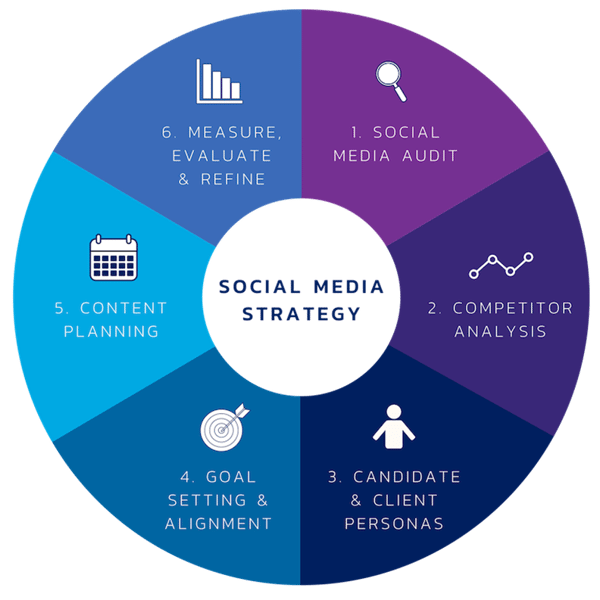
How to create a social media strategy
1. Conducting a social media audit
Before diving head first into a social media strategy, you need to conduct an audit of your existing social media channels. This will help you document what is and isn’t currently working for your recruitment firm.
You should ask yourself questions such as:
- What type of content performs the best on each channel?
- Who is following us on social media?
- Are we posting too much or too little?
- Are our visuals and messaging on brand?
This should give you a clear idea as to whether you are on the right channels for your target audiences, or if you need to scale back and concentrate your resources on the platforms they are most active on.
2. Competitor analysis
After reviewing your own social media presence you should now look at your competition and assess what they are doing across their channels. This will not only highlight what is working well for them but it will also help you spot opportunities you could capitalise on.
You should look at key aspects of their channels, such as:
- Number of followers
- Post frequency
- Top performing content
3. Develop candidate and client personas
Do you know what your ideal candidates and clients look like? You need to have an understanding of who exactly they are and how they arrive at decisions if you are to produce content that resonates with your target audiences.
This is where candidate and client personas come into play - these are fictional representations of your business’s ideal customers which enable you to clearly define and segment your firm’s audiences.
Where can I source data for candidate and client personas?
So how can you start gathering the required data to develop your personas? Here are four simple methods that your recruitment firm can implement:
- Integrate it into the on-boarding process – you should liaise with your recruitment consultants to ensure they are asking relevant questions and recording the responses they receive into dedicated fields of your CRM system.
- Look at the LinkedIn profiles of candidates and clients – if their profiles have been completed and they actively use the platform, their LinkedIn accounts will provide a wealth of valuable information, from their employment history and qualifications through to the type of content that they engage with and the LinkedIn groups they are members of.
- Interview previously hired candidates – you should work with your consultants to ensure that their follow up communications with successfully placed candidates include questions on their career aspirations and interests. This will provide you with regular insights that you can use to develop and refine your personas.
- Send out targeted surveys that offer an incentive – you should segment your database into small groups and target individuals with themed surveys containing questions relevant to their job roles. For example, you could design one that aims to find out the top bugbears of applying for a new role or what the biggest challenges facing HR directors are. Offering a small prize or incentive, such as a gift card for a lucky respondent, will help increase participation.
What questions should I ask?
To gain the insights needed to produce accurate candidate and client persona, you should ask a diverse range of questions that cover their demographics, psychographics and webographics. To do this effectively, you should try and ask questions from each of the six categories in the below template.
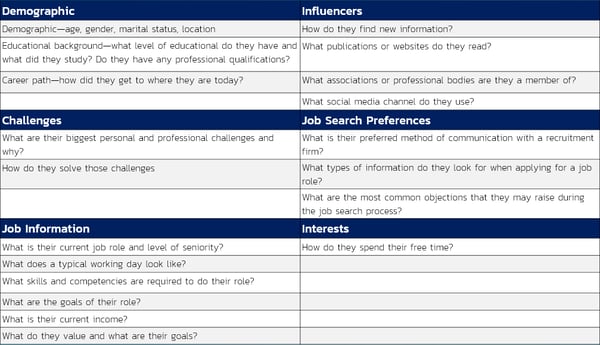
How can I analyse my data to produce candidate and client personas?
Once you have collated this data you will need to carefully work through it to identify any recurring themes or trends and use this to highlight your audiences’ key characteristics.
I recommend working with your recruiters to ensure that you are getting more than one function’s perspective. This will also give you the opportunity to tap into and cross-reference their pre-existing knowledge of candidates’ interests, aspirations and challenges.
Once you have finalised their ideal characteristics you should try and have a little fun with your candidate personas by bringing them to life and making them memorable with a suitable name and image (like the example below).
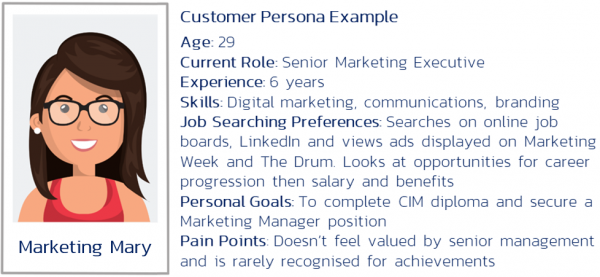
4. Setting and aligning goals
Once you have created your personas you should review your recruitment firm’s overall business objectives and develop social media goals that support them. This is to ensure that your social media works in tandem with business activities and drives measurable outcomes.
For this to be achievable, your social media goals need to be SMART:
- Specific
- Measurable
- Attainable
- Relevant
- Time-bound
Below are three examples of business objectives that your firm may have and the social media goals that could be aligned with them:
- Business objective: Increase regional brand awareness
Social media goal: Acquire 30 new Twitter followers each month that reside within that region - Business objective: Increase the number of candidate leads
Social media goal: Increase the number of candidate registrations generated via LinkedIn by 5% month-on-month - Business objective: Increase overall website traffic
Social media goal: Increase the number of website visits from Facebook by 10% month-on-month
Creating SMART social media goals will also make it far easier to demonstrate the value of your work to the wider business and secure executive buy-in.
5. How to plan your social media content
After establishing your personas and setting your goals, you should now have the knowledge and direction to produce content which meets the needs of your potential clients and candidates and achieves business objectives.
Engaging social media content should be:
- Educational
- Informative
- Inspiring
- Entertaining
- And provide value
It is vital that you create a posting schedule which lists the dates and times you will publish posts across your channels. You should pull together the insights from your audits, personas and each channel’s analytics to map out the times your audiences are most active and ensure you are posting the optimal number of posts for each one.
Whilst it is tempting for recruitment firms to share a stream of job vacancies to drive leads, a balanced approach to content is needed to ensure authentic engagement. At BlueSky PR, we use the ‘Rule of Thirds’ social media model (below) to ensure that client content attracts and maintains an engaged following.
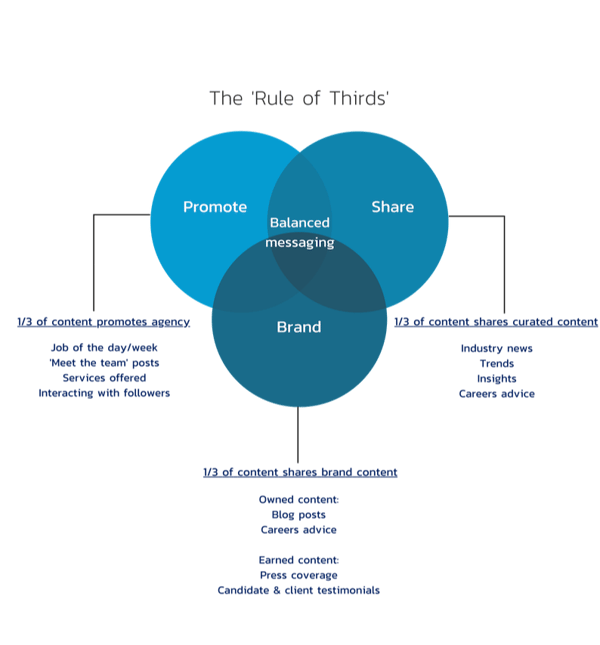
This is where:
One third of your content promotes your agency and converts the audience
If someone is following your firm on social media then the chances are they have an interest in your services and, as such, you should be promoting these.
However, don’t be too ‘salesy’– ensure that the amount of promotional content is varied and not too pushy in tone. For example, rather than posting vacancy after vacancy, why not post a job of the day? Or produce a series of meet the team images which introduce your consultants to the wider social media audience?
The latter is not only a much more subtle way of promoting your services but by including a fun fact or two it is also more likely to be remembered by a potential client or candidate.
One third shares curated content
Many marketers, regardless of industry, can be sceptical about sharing third-party content on their channels. However, by using the information gleaned from your personas you can curate information that adds real value to your audience and positions your brand as a ‘go to’ for the latest news and insights.
This also helps demonstrate your agency’s wider knowledge of the sectors it works in to potential clients and candidates.
One third is branded content
The final third is the one that should come easiest to agencies and is about showcasing your brand and the value you can add to clients and candidates. This should consist of owned content, such as blog posts and careers advice hosted on your website, as well as earned content like press coverage and candidate/client testimonials.
By demonstrating the credibility of your brand on social media you are much more likely to attract new followers and generate leads.
The ‘Rule of Thirds’ will help shape the key components of your social media strategy and provide you with an effective way of balancing your recruitment agency’s social media content.
Once you have this content model in place, it is vital that you monitor your social media closely so that you not only engage with any positive comments your recruitment firm receives, but are also well positioned to respond to any negative ones. This will help you minimise the risk of a PR crisis happening.
How to successfully implement employee advocacy
While having content that really resonates with your target audiences is of course key for engagement, employee advocacy can really take it up to the next level.
Employee advocacy, the act of engaging staff to share their business’ content on social media, is known to be a powerful mechanism in boosting brand awareness amongst new audiences, and should certainly be encouraged by every business leader. However, while staff should be coaxed to share content and promote the business, it should always be voluntary and authentic. Good programmes will ensure that this is a mutually beneficial exchange. Here’s how to encourage employee advocacy the right way.
The benefits of employee advocacy
There are a number of benefits associated with establishing an employee advocacy programme.
However, what really highlights its effectiveness is data from LinkedIn which shows that on the platform:
- Employees have, on average, a network 10x larger than the follower count of the company that they work for
- When employees share content, it’s viewed as 3x more authentic than when viewing it directly from the original company post
- Employee re-shares of company content have a click-through rate of 2.1x that of the original company post
Tips for implementing employee advocacy
There are a number of ways to encourage employee advocacy at your organisation:
- Establish brand champions - Look at those within your organisation who are social media savvy and are already sharing brand content on LinkedIn and get them involved first. Position them as brand champions and ask them to share the positive results they have experienced with the rest of the business – this will help secure buy-in from those sceptical of the power of social media and provide them with tangible examples that they can replicate.
- Hold a workshop - You should train your recruiters on how to use social media to promote your brand – whether that’s through a formal training session or an informal lunch and learn. You should use this as an opportunity to run through the social media policy, provide examples of employee advocacy and answer any questions that they may have. This is also the perfect time for your brand champions to demonstrate their own successes to the rest of the business.
- Track engagement – This is vital to see who in your organisation is proactively engaging with your social media and allows you to monitor the overall levels of engagement over a period of time.
- Recognise and incentive employees – As they say, a little recognition goes a long way and you should consider creating a recognition programme to help incentivise employees and give them the push that they need to get started. For example, each month the employee who has shared the most posts could be awarded a small prize.
6. How to measure, evaluate and refine your social media strategy
Your social media strategy is a hugely important document for your recruitment firm that will evolve over time depending on your business objectives, social media goals, and, of course, results.
This is why it is vital to use the SMART goals you have set to measure your social media performance effectively and demonstrate its ROI. This also enables you to avoid one of the biggest mistakes made by recruitment firms which is reporting on what are commonly known as ‘vanity metrics’. These are metrics such as follower growth, likes, comments and shares which are reported on in isolation as opposed to being directly tied to your business objectives.
Whilst solely focusing on ‘vanity metrics’ is detrimental to your social activities, you should collate additional metrics from your channels and Google Analytics to help inform your decision-making and uncover trends. These may include:
- Impressions
- Page/profile views
- Engagement rate
- Comments, retweets, shares and likes
- Click-throughs
- Brand mentions
- Follower growth
- Website referral traffic via social
- Bounce rate via social
- Average time on site via social
Once you have decided on these supporting metrics, you will be able to benchmark your performance, evaluate your data and most importantly learn from it. This is essential so that you can refine your strategy on an ongoing basis as and when needed.
The benefits of using paid social for recruitment firms
Over the last few years social media has evolved into what has been termed a ‘pay to play’ arena as algorithms make it much more difficult for content from businesses and brands to be seen organically in users’ feeds. A prime example of this is Facebook where overall page engagement has fallen by 50% thus emphasising the need for businesses in all industries, including recruitment, to invest in paid social if they want to be seen by their existing followers and also target their ideal audiences.
There are a number of benefits that paid social media campaigns can offer your recruitment business, including:
- Ensuring maximum visibility among your existing followers
- Increasing brand exposure
- Reaching passive candidates
- Using the advanced targeting features to accurately target individuals that possess the skills and experience needed to excel in an advertised role
- Showcasing your company culture to a wider audience
With an increasing number of recruitment businesses utilising social media advertising to great effect, it is recommended to monitor what others in your sector are doing if you are to be aware of the latest trends and stay one step ahead of the competition. You can learn how to view your competitors’ social media ads in this blog post.
For more information on getting started with social media advertising contact us today, or watch our free on-demand ‘Using Paid Social for Recruitment’ webinar.
Should recruitment firms outsource social media?
Social media, like all recruitment marketing activities, requires dedicated time and resources to make it a success. It is important that you evaluate whether or not you have the capacity to manage the day-to-day activities in-house, or if it would be far more beneficial to outsource it to a specialist agency.
There are a number of benefits as to why you should consider outsourcing your social media. These include:
- Expertise – A specialist agency will know everything from the basics, such as the optimum number of hashtags posts that should be use on each platform, through to more advanced aspects, such as running paid social media campaigns and producing a measurable strategy.
- Productivity – Social media is constantly evolving with new features, policy updates and algorithm changes being rolled out on a regular basis. Can your employees keep abreast and make use of the latest developments whilst also coming up with fresh ideas, producing content, scheduling posts and analysing data? This can be even more problematic when you consider that your employees have other aspects to their job role, such as admin or operations tasks, that take up time and can understandably take priority.
- Cost - With the average UK salary for a social media manager reaching £33,065 per year, it would require a significant investment to hire an individual with the skills, knowledge and qualifications needed to successfully manage your brand’s social media presence.
In comparison, outsourcing is far more cost-effective than paying a full-time salary and you are guaranteed someone who possesses the social media expertise that your recruitment business needs to succeed.

